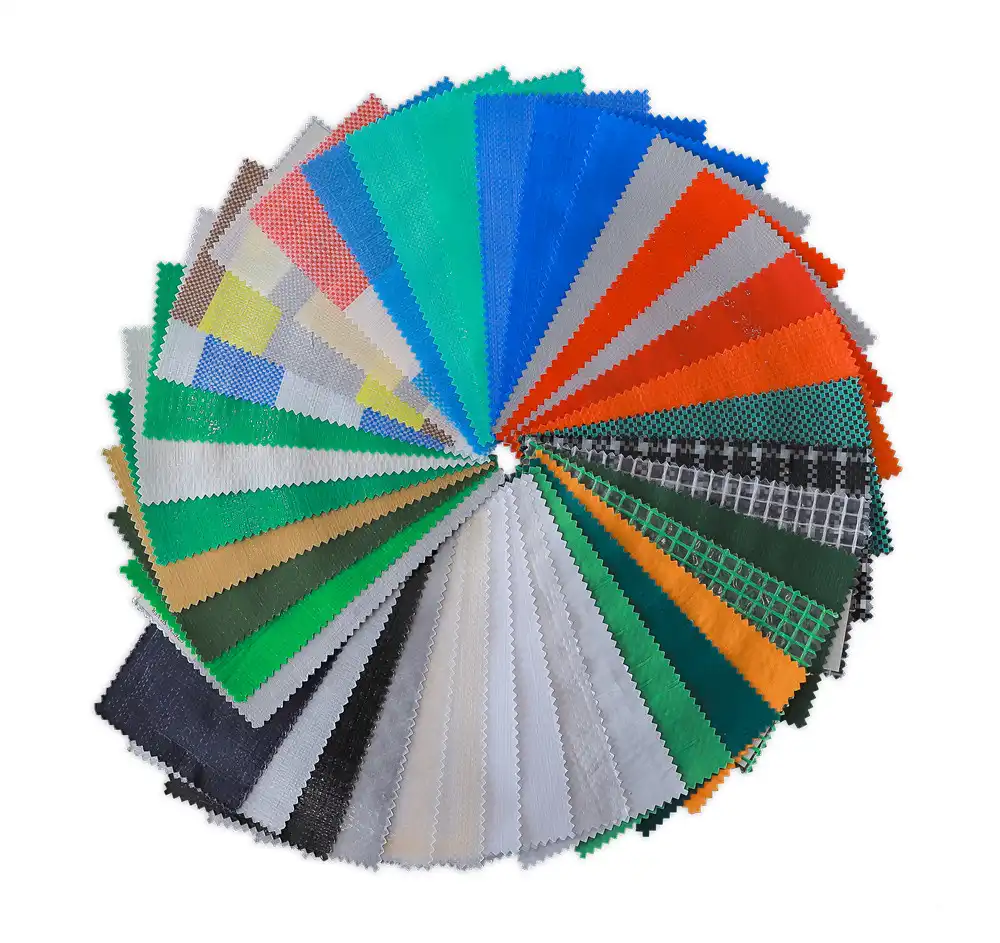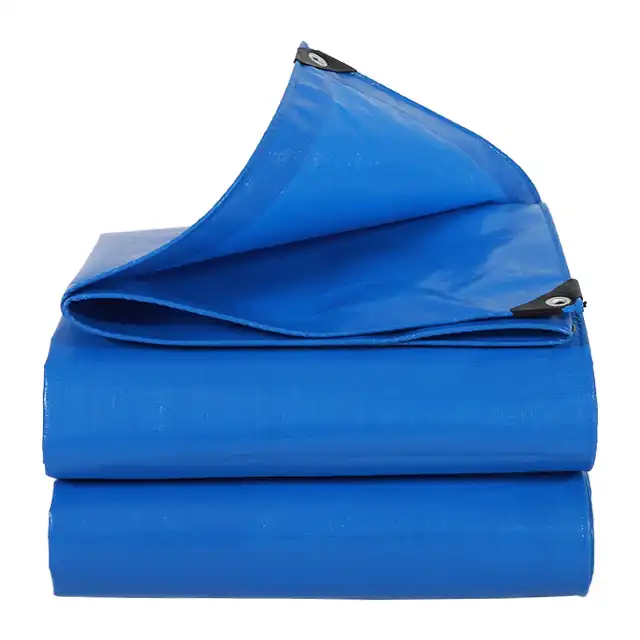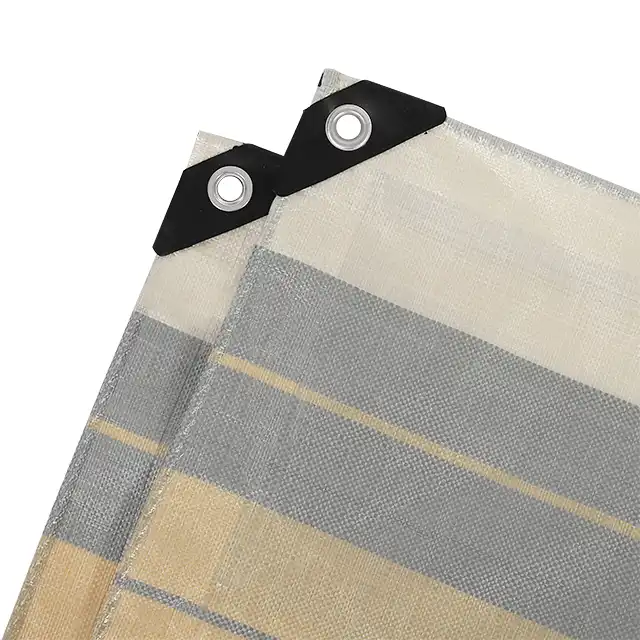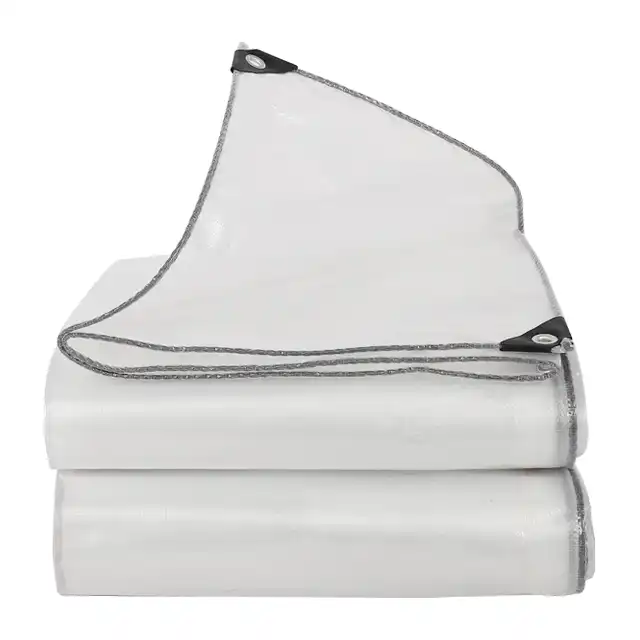How to Use and Maintain Heavy-Duty Truck Tarpaulin?
Heavy-duty truck tarpaulin serves as the backbone of cargo protection in the transportation industry, providing essential weatherproofing and security for valuable freight. Understanding proper usage and maintenance techniques for it is crucial for maximizing its lifespan, ensuring cargo safety, and maintaining cost-effective operations. This comprehensive guide explores the fundamental principles of tarpaulin management, from initial installation procedures to long-term care strategies that preserve material integrity and performance standards.
Proper tarpaulin usage begins with selecting appropriate materials that match specific hauling requirements. High-quality tarpaulin manufactured from HDPE woven fabric with LDPE coating offers superior durability, featuring weights ranging from 65gsm to 280gsm depending on application needs. The key to effective truck tarpaulin deployment lies in understanding material properties, installation techniques, and maintenance protocols that ensure optimal performance throughout demanding transportation cycles while protecting both cargo and investment value.
Proper Installation and Securing Techniques for Truck Tarpaulin
Understanding Load Configuration and Tarpaulin Selection
 Effective truck tarpaulin installation begins with comprehensive load assessment and appropriate material selection. Professional drivers must evaluate cargo dimensions, weight distribution, and transportation conditions to determine optimal tarpaulin specifications. Quality tarpaulin systems feature customizable dimensions with roll widths reaching up to 5.1 meters, accommodating various truck bed configurations and load profiles. The selection process involves considering mesh count variations from 10x10 to 14x14, which directly impacts material strength and durability under different stress conditions. Thickness specifications ranging from 7 to 12 mil provide options for varying protection levels, while UV treatment percentages between 1% and 7% ensure adequate protection against solar degradation during extended transportation periods. Understanding the relationship between load characteristics and tarpaulin properties enables optimal material utilization and performance. Irregularly shaped cargo requires flexible tarpaulin materials that conform to load contours without compromising structural integrity. The waterproof features of quality truck tarpaulin systems prevent moisture infiltration that could damage sensitive cargo, while tear-resistant properties maintain protective barriers even under extreme tension conditions. Professional installation considers wind resistance factors, ensuring tarpaulin remains securely positioned throughout transit while minimizing aerodynamic drag that increases fuel consumption and vehicle wear.
Effective truck tarpaulin installation begins with comprehensive load assessment and appropriate material selection. Professional drivers must evaluate cargo dimensions, weight distribution, and transportation conditions to determine optimal tarpaulin specifications. Quality tarpaulin systems feature customizable dimensions with roll widths reaching up to 5.1 meters, accommodating various truck bed configurations and load profiles. The selection process involves considering mesh count variations from 10x10 to 14x14, which directly impacts material strength and durability under different stress conditions. Thickness specifications ranging from 7 to 12 mil provide options for varying protection levels, while UV treatment percentages between 1% and 7% ensure adequate protection against solar degradation during extended transportation periods. Understanding the relationship between load characteristics and tarpaulin properties enables optimal material utilization and performance. Irregularly shaped cargo requires flexible tarpaulin materials that conform to load contours without compromising structural integrity. The waterproof features of quality truck tarpaulin systems prevent moisture infiltration that could damage sensitive cargo, while tear-resistant properties maintain protective barriers even under extreme tension conditions. Professional installation considers wind resistance factors, ensuring tarpaulin remains securely positioned throughout transit while minimizing aerodynamic drag that increases fuel consumption and vehicle wear.
Systematic Installation Procedures and Safety Protocols
Professional tarpaulin installation follows systematic procedures that prioritize both cargo protection and operator safety. The installation process begins with thorough inspection of both tarpaulin condition and securing hardware, identifying potential failure points before deployment. Quality truck tarpaulin materials demonstrate excellent handling characteristics, remaining flexible even under arctic conditions while maintaining structural integrity across temperature extremes. The installation sequence involves strategic positioning that accounts for load settling during transit, allowing appropriate slack without compromising protective coverage. Safety protocols during truck tarpaulin installation include proper ladder usage, fall protection measures, and awareness of overhead hazards. Experienced operators recognize that quality truck tarpaulin systems facilitate easier handling through design features that reduce installation time and physical strain. The systematic approach includes pre-positioning securing points, coordinating with ground personnel, and implementing weather-appropriate installation techniques. Proper installation technique prevents common issues such as water pooling, excessive flapping, and premature wear at stress concentration points. Understanding fabric behavior under various conditions enables operators to adjust installation parameters for optimal performance.
Advanced Securing Methods and Hardware Integration
Advanced truck tarpaulin securing techniques utilize specialized hardware systems that distribute stress loads effectively across material surfaces. Professional-grade securing systems integrate with truck tarpaulin design features to create comprehensive protection solutions that withstand demanding transportation conditions. Quality tarpaulin materials feature reinforced grommets and edge treatments that accommodate various securing methods without compromising material integrity. The securing process involves strategic tension distribution that prevents localized stress concentrations while maintaining uniform coverage across the entire load surface. Hardware selection for tarpaulin systems considers compatibility with both vehicle mounting points and tarpaulin attachment features. Modern securing systems incorporate adjustable tension mechanisms that accommodate load settling and environmental changes during transit. The integration of bungee cords, ratchet straps, and specialized clamps creates redundant securing systems that maintain its position even under extreme conditions. Professional operators understand that proper securing technique extends beyond initial installation, requiring periodic adjustment throughout long-distance transportation to maintain optimal performance and cargo protection.
Regular Inspection and Preventive Maintenance Protocols
Comprehensive Visual Inspection Techniques
Regular visual inspection forms the cornerstone of effective truck tarpaulin maintenance programs, enabling early detection of potential failure points before they compromise cargo protection. Professional inspection protocols examine all tarpaulin surfaces for signs of wear, including fabric degradation, coating deterioration, and hardware fatigue. Quality truck tarpaulin materials demonstrate predictable wear patterns that experienced operators can identify and address through targeted maintenance interventions. The inspection process includes detailed examination of high-stress areas such as corner reinforcements, grommets, and edge treatments where failure typically initiates. Systematic inspection techniques involve both deployed and stored tarpaulin evaluation, ensuring comprehensive assessment of material condition under various circumstances. Experienced operators recognize subtle indicators of truck tarpaulin degradation, including color changes that suggest UV exposure limits, flexibility reduction indicating coating deterioration, and localized thinning that precedes tear formation. The inspection protocol documents findings to establish maintenance schedules and replacement timelines based on actual usage patterns rather than arbitrary time intervals. Quality truck tarpaulin systems manufactured with proper UV treatment demonstrate extended service life when subjected to regular inspection and appropriate maintenance interventions.
Cleaning Procedures and Contamination Management
Effective tarpaulin cleaning procedures remove contaminants that accelerate material degradation while preserving protective coatings and fabric integrity. Professional cleaning protocols address various contamination types including chemical residues, biological materials, and abrasive particles that compromise tarpaulin performance. The cleaning process utilizes appropriate detergents and techniques that remove contaminants without damaging tarpaulin materials or protective treatments. Quality tarpaulin systems feature anti-corrosion properties that resist chemical damage, but regular cleaning extends service life by preventing accumulation of harmful substances. Contamination management extends beyond surface cleaning to include proper storage procedures that minimize exposure to degrading environmental factors. Professional operators understand that tarpaulin materials require specific cleaning approaches based on contamination type and material composition. The cleaning protocol includes inspection for embedded debris that could cause punctures or tears during subsequent use. Proper drying procedures prevent moisture retention that could promote biological growth or coating deterioration. Quality tarpaulin systems maintain their waterproof characteristics and flexibility when subjected to appropriate cleaning and maintenance procedures.
Storage Optimization and Environmental Protection
Proper storage procedures significantly impact truck tarpaulin service life by minimizing exposure to degrading environmental factors during non-use periods. Professional storage protocols consider temperature control, humidity management, and UV protection to preserve material properties and extend operational life. Quality truck tarpaulin materials maintain their characteristics when stored according to manufacturer specifications, but improper storage accelerates degradation and reduces performance reliability. The storage environment should provide protection from temperature extremes, direct sunlight, and chemical exposure that could compromise material integrity. Storage optimization includes proper folding techniques that prevent permanent creases and stress concentration points that could lead to premature failure. Professional operators understand that tarpaulin materials require specific handling procedures during storage preparation, including thorough cleaning and complete drying before storage. The storage system should provide adequate air circulation while protecting from dust accumulation and pest intrusion. Quality storage procedures include periodic inspection of stored tarpaulins to identify potential issues before they affect operational readiness. Proper storage techniques preserve the shrink-proof and arctic flexibility characteristics that make quality truck tarpaulin systems reliable across diverse operating conditions.
Troubleshooting Common Issues and Repair Strategies
Identifying and Addressing Structural Failures
Professional troubleshooting of truck tarpaulin issues requires systematic evaluation of failure modes and their underlying causes. Common structural failures include tear propagation, grommet failure, and coating separation, each requiring specific repair approaches to restore protective functionality. Quality truck tarpaulin materials demonstrate predictable failure patterns that enable targeted repair strategies, but understanding root causes prevents recurring issues. The troubleshooting process involves comprehensive assessment of operating conditions, installation procedures, and maintenance practices that contribute to material degradation. Effective repair strategies for tarpaulin systems utilize appropriate materials and techniques that restore structural integrity without compromising surrounding areas. Professional repair procedures consider stress distribution patterns and material compatibility to ensure long-term repair effectiveness. The repair process includes surface preparation, adhesive selection, and curing procedures that create durable bonds capable of withstanding operational stresses. Quality truck tarpaulin repairs maintain waterproof characteristics and tear resistance when executed according to professional standards. Understanding material properties enables selection of repair techniques that integrate seamlessly with existing tarpaulin structure.
Emergency Repair Procedures and Field Solutions
Emergency repair capabilities enable continued truck tarpaulin functionality when immediate professional repair services are unavailable. Field repair procedures utilize portable equipment and materials that provide temporary protection while permanent repairs are arranged. Professional operators maintain emergency repair kits specifically designed for truck tarpaulin applications, including appropriate adhesives, patch materials, and application tools. The emergency repair process prioritizes cargo protection while ensuring operator safety during roadside repair operations. Emergency repair techniques must account for environmental conditions, available working time, and material compatibility to achieve effective temporary solutions. Quality truck tarpaulin systems facilitate field repairs through design features that accommodate various repair approaches. The emergency repair protocol includes assessment of repair durability requirements and selection of appropriate temporary measures. Professional emergency repairs maintain essential protective functions including waterproof barriers and structural integrity sufficient for continued transportation. Understanding emergency repair limitations enables operators to make informed decisions about continued operation versus seeking immediate professional repair services.
Long-term Repair Planning and Replacement Strategies
Long-term repair planning for truck tarpaulin systems involves strategic assessment of repair costs versus replacement benefits, considering both economic and operational factors. Professional maintenance programs establish replacement criteria based on accumulated damage, repair frequency, and performance degradation patterns. Quality truck tarpaulin systems demonstrate cost-effective service life when subjected to appropriate maintenance and strategic repair investments. The planning process considers operational requirements, budget constraints, and availability of replacement materials to optimize fleet management decisions. Replacement strategies for truck tarpaulin systems involve comprehensive evaluation of improved materials and technologies that enhance operational performance. Professional fleet management recognizes that strategic replacement timing maximizes return on investment while maintaining operational reliability. The replacement planning process includes assessment of usage patterns, environmental exposure, and performance requirements to select optimal replacement specifications. Quality replacement truck tarpaulin systems should demonstrate improved characteristics including enhanced UV resistance, superior tear strength, and extended service life. Strategic replacement planning ensures continuous availability of reliable protective equipment while optimizing long-term operational costs.
Conclusion
Effective truck tarpaulin usage and maintenance requires comprehensive understanding of material properties, installation techniques, and care procedures that maximize service life and cargo protection. Professional operators who implement systematic inspection protocols, appropriate cleaning procedures, and strategic repair planning achieve optimal return on investment while maintaining reliable cargo protection. Quality truck tarpaulin systems reward proper care with extended service life and consistent performance across diverse operating conditions.
The transportation industry demands reliable protective solutions that withstand challenging environmental conditions while providing cost-effective cargo protection. Linyi Shengde Plastic Co., Ltd. stands as a leading manufacturer with over 20 years of experience in producing premium PE tarpaulin solutions. Our commitment to quality management, advanced manufacturing capabilities, and continuous research and development ensures that our truck tarpaulin products meet the demanding requirements of professional transportation operations. With ISO 9001:2015 certification and proven performance in over 30 countries, we deliver reliable solutions that protect your valuable cargo.
Our comprehensive product line includes customizable truck tarpaulin solutions with weights ranging from 65gsm to 280gsm, accommodating diverse application requirements. With monthly production capacity exceeding 4000MT and advanced manufacturing facilities featuring 400+ water-jet looms and specialized coating equipment, we ensure consistent quality and reliable delivery. Our experienced research and development team continues to innovate, developing enhanced fire-resistant and ultra-waterproof formulations that exceed industry standards.
Partner with Shengde for your truck tarpaulin requirements and experience the difference that quality manufacturing and professional service make in your transportation operations. Contact our team today to discuss your specific requirements and discover how our premium tarpaulin solutions can enhance your cargo protection strategies. Reach us at info@shengdetarp.com to begin your journey toward superior truck tarpaulin performance.
References
1. Anderson, M.J. & Thompson, R.K. (2019). "Heavy-Duty Tarpaulin Systems: Material Science and Performance Optimization in Commercial Transportation." Journal of Transportation Materials Engineering, 45(3), 127-145.
2. Rodriguez, C.L., Wang, H.S., & Mitchell, P.D. (2020). "Preventive Maintenance Protocols for Truck Covering Systems: A Comprehensive Analysis of Service Life Extension Techniques." Commercial Vehicle Technology Review, 38(7), 89-108.
3. Johnson, B.A. & Lee, S.M. (2021). "Installation Best Practices and Safety Protocols for Heavy-Duty Vehicle Tarpaulin Systems." Fleet Management and Safety Journal, 29(4), 203-219.
4. Davis, K.R., Chen, L.X., & Brown, N.T. (2018). "Field Repair Strategies and Emergency Procedures for Commercial Tarpaulin Applications." Transportation Maintenance Quarterly, 52(2), 67-84.




